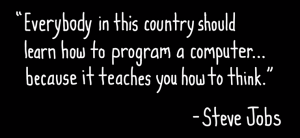Coding in Schools – Creating a Culture of Innovation in Education
Most of my memories from elementary school are foggy. But I vividly remember playing word munchers on a orange screen computer in Kindergarten. It is surprising to me that 30 years later my own children talk about how they have to wait two weeks to get computer time at school but at home they can code and build Web pages easily. I would have thought that by now, computers would be integrated into everything we do in schools and there wouldn’t be a rotation with a two week wait time. Technology shouldn’t be a rotation in their classroom and it shouldn’t be on the back burner of education.
In the opening splash quote to the 2013 video What Most Schools Don’t Teach (that has been seen over 12.5 million times), Steve Jobs highlights this notion perfectly:
There is nothing more important than teaching our students how to think. Our schools are the PERFECT place to teach future generations all the soft skills they will need in our rapidly changing world. What I mean is this, learning how to code isn’t so much about learning the languages (HTML, CSS, JavaScript, Objective-C, Swift, Java, Ruby, etc.). Its about learning how to think, collaborate and solve problems. In our schools right now we can develop human beings to do these things and it won’t cost a thing. These competencies don’t show up on standardized tests and they aren’t a shiny new silver bullet to write books about but they are the foundation of building the future career force of America.
Will.i.am was my students favorite celebrity when I showed the video on our school news channel to promote our new coding club back in 2013 (see my Nov 6, 2013 blog post here). He said: “We all depend on technology to communicate. And none of us know how to read and write code.” So true. So what can we do about it? We urgently started a Minecraft club, and then a coding club. Our first day of coding club back in 2013, we had over 80 students stay after school. We had a developer speak to the students and 4-5 students were huddled around a laptop learning Scratch. That afternoon, and many since, our students learned how to program the simplest forms of their favorite games. Now that we are 1:1 with Chromebooks the learning is endless! Their minds are opened to a whole new world. Fast forward to this fall when we will offer our first technology education elective, Project Lead The Way’s Computer Science class. When I described this class to my students, the response was overwhelming. They ALL wanted to sign up.
We should be offering classes like this in all of our schools but more importantly we should be integrating these foundational skills for this work all throughout our current framework for education. Some of my math teachers have shifted their thinking just in this way. Last winter they went to the national math conference and came back with many new ideas. The one I was particularly happy to hear about was that they are taking a new approach to teaching math. It doesn’t matter how you solve the problem. They just want to see your process. This approach to learning directly influences future technologists in understanding the process in solving the problem. When we encourage outside-the-box thinking this way, we help build foundational skills for the future! We need future technologists who can problem-solve, think critically, be creative, work collaboratively and have a growth mindset. We can teach these skills in schools.
The soft skills that are needed for the future can and should be built in our schools so all kids can learn to program computers, code and work in one of the 2.8 million STEM jobs openings predicted for 2018. Focusing on career readiness means focusing on developing the skills that will allow our students to be college and career ready for their futures, not our past.
Resources to teach coding: www.wibki.com/GetCoding

